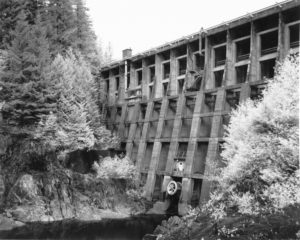Camosun lab technologist Michael McLean has been hard at work outside the classroom, working on his photography project JR. The project—which McLean is hoping to eventually turn into a book—focuses on the hamlet of Jordan River, which has been overtaken by BC Hydro as they do a six-year seismic survey of the region. The survey is centred around the Jordan River Diversion Dam, located 12 kilometres upstream from the hamlet.
The results of BC Hydro’s findings fuelled a creative spark in McLean. When he heard that the dam would collapse in the event of an earthquake, potentially washing out nearby civilization, he wanted to find a vehicle to communicate his thoughts on the matter.
“The picture that that painted in my mind of living in one of those homes and constantly, in the back of your mind, thinking that there’s this massive reservoir 12 kilometres away… An earthquake is a scary enough event as it is, but when you know that there’s this wall of water that could be rushing down the mountain toward your home, it just painted an incredibly vivid picture in my mind,” says McLean.

McLean uses various photo techniques in JR, including infrared, which allows him to capture artistic moments in time that would otherwise be undetectable to the human eye.
“That relates directly to the film stock that I’m using,” he says. “Infrared actually doesn’t pick up on the normal wavelength of life. When it was initially developed, it was developed for scientific and medical application.”
McLean says that BC Hydro has made the area very difficult to get to, so he drives as far as he can and then starts hiking in. He starts early in the morning, walking in with his tripod and camera—around 40 pounds worth of equipment—to start shooting.
“I made a series of photographs from the dam site, and there was also some really interesting stuff on the way to the dams; there were shooting ranges. These are represented in the photographs [with] burnt-out mattresses and shell casings. It just became really rich, photographically, to look at that landscape and the way that people engage with it.”
McLean says that the point of JR is not to make a judgement call; rather, it’s just to document what is happening in that region.
“It’s not that I’m in any way disparaging or trying to make a negative comment about different types of ways that people recreate in that landscape,” he says. “That’s not really the point at all. It’s just really intriguing for me to learn more about the place and the way that people engage with the landscape, and I’m doing the same thing.”
Although McLean’s engagement fuels his creative process, he says a sense of weariness—a feel of living off borrowed time—is present in the finished works.
“There’s an appreciation for the ruggedness and the beauty of that place,” he says, “but there’s a certain element of danger in it, just with the knowledge that that dam is 100 years old. You get up close to it and the concrete is crumbling.”
JR is online at mikeandrewmclean.com/works/jordan-river.
